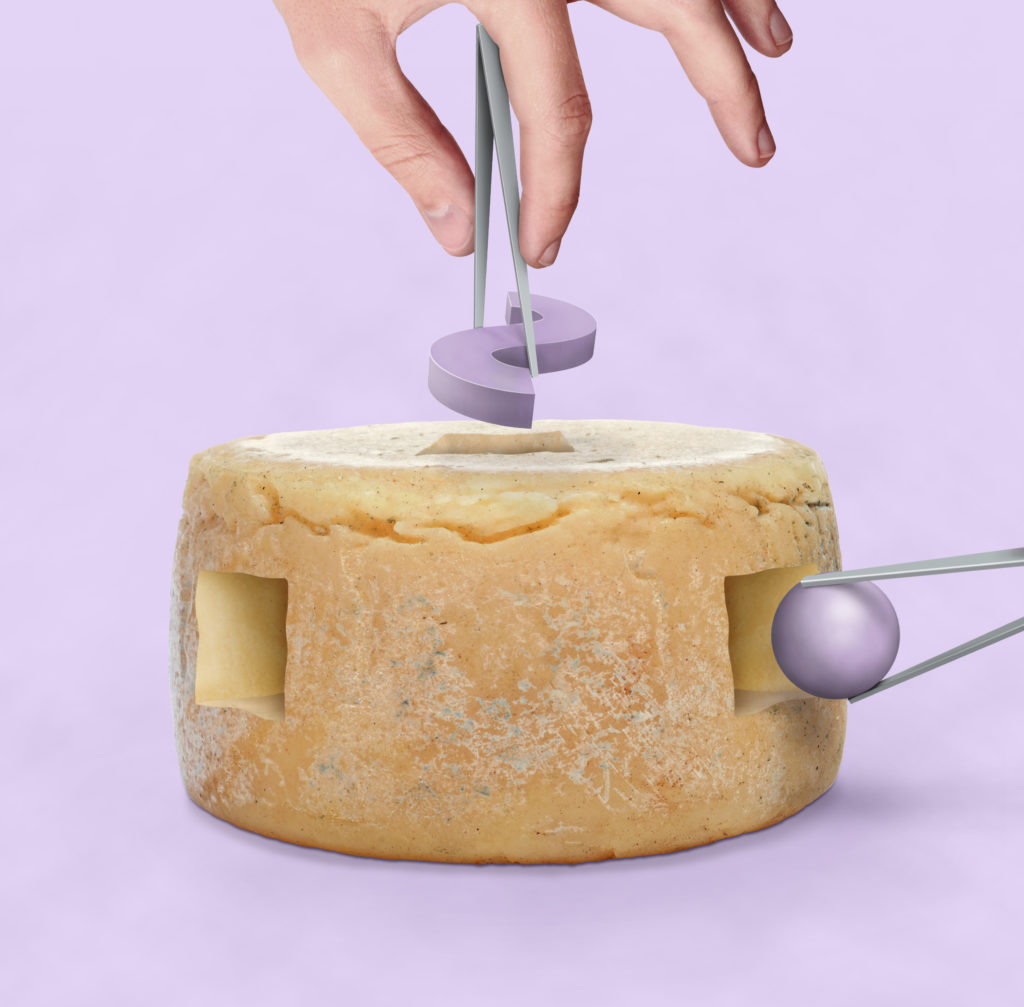illustrations Pascal Tieman
By 2020 it should be easy for the Dutch to avoid eating too much salt, saturated fat and calories. To this end, the food industry and the government have signed a National Agreement to Improve Product Composition. But Secretary of State Paul Blokhuis is not satisfied about the progress being made. He would like to see the industry stepping up efforts to reach the targets set, as he made clear in a parliamentary memo at the end of 2017.
The improvements that need to be made to readymade foods such as snacks, sauces, cookies, cheese and bread often generate tricky technical puzzles, says Miriam Quataert of Wageningen Food & Biobased Research (WFBR). She is expertise leader in the Product Physics & Application group and leads a lot of research into how to make food products healthier by changing their composition – product reformulation in the jargon.
Not as crunchy
Companies often start by trying to cut down the salt, sugar and fat in their products themselves by trial and error,’ says Quataert. ‘In that first phase they often take steps in the right direction but at some point they run up against their limits. And then they lack the expertise or the apparatus to get any further.’ Some of these companies come to Food & Biobased Research for support, sometimes bilaterally and sometimes in the context of joint projects with other producers or branch organizations.
But what makes it so difficult to make products healthier? ‘A food item is a composite product,’ explains Quataert. ‘There is a great deal of interaction between all the ingredients, as well as between the preparation process and the ingredients. If you change just one ingredient, you often influence several things, such as taste, texture or shelf life.’

With reduction, the first few percent are easy, then it gets harder
Miriam Quataert, Wageningen Food & Biobased Research
Quataert and her team have done a major study on reducing salt levels in snacks, for instance. It turned out that this not only made the snack taste less salty, but also changed other taste components. This is because salt is a flavour enhancer.

Breakfast cake
These examples make it clear how much difference a seemingly small change in a recipe can make. And in most cases, salt is only a minor ingredient. Tinkering with the main ingredients in a recipe is even trickier, says Quataert. ‘Cakes, for instance, are full of sugar. Imagine you replace the sugar with a calorie-free sweetener such as stevia. You will need very little stevia to achieve the same degree of sweetness.’ So how, then, do you get a good batter and end up with a firm, voluminous cake? That will require more changes than simply replacing sugar with stevia.
Quataert: ‘So you have to opt for other low-calorie molecules with characteristics similar to those of sugar, in terms of texture, structure, colour and so on. Through our research, we are able to identify suitable candidates based on a few molecule characteristics.’
This is the approach that was taken when the manufacturer of the spicy Dutch ‘breakfast cake’, Peijnenburg, came knocking at the door of research organization TNO – which has now joined forces with WFBR for nutrition and biobased research. Peijnenburg wanted to make a breakfast cake with no added sugar. The researchers started by analysing the function of the sugar in the gingerbread, paying attention to way sugar contributes to things like colour, crumbliness, taste, crunchiness and sweetness. Then, for each of these characteristics they looked for alternative, low-calorie ingredients that would provide them. Those ingredients were then added and the cake was tested for consistency and flavour, among other things. The best alternative for fulfilling the function of sugar proved to be a combination of the sweetener xylitol and the slightly sweet nutritional fibre oligofructose.
Statistical models
The complicating factors for reducing the fat in cheese are the creaminess and softness – known in the cheese world as malleability. With less fat and more protein, cheese becomes drier, as was seen in a project with Arina goat’s cheese. Nevertheless, recalls Quataert, a tasty light variant was eventually developed. ‘In this case we looked for and found the solution in a smart choice of ferments, the bacterial cultures used in cheesemaking for converting lactose into lactic acid. This enabled us to develop a goat’s cheese with less fat and more protein.’ To get a better understanding of product reformulation, and to speed up the process, the food technologists make use of models. Things like the function of sugar in cake and that of salt in snacks are expressed in physical and statistical models. Such models provide insight into the relation between the ingredient in question and the characteristics of the end product. The technologists use these insights to formulate rules which will ensure the recipe and preparation method yield a good end product. Those rules can then be applied in the development of other products with reduced sugar or salt levels.

Taste tests
The researchers test the healthier alternatives they have developed on consumers as well. After all, in the end the point is that people should enjoy the adapted products, otherwise they won’t switch to them. ‘One of the things we want to understand is exactly which aspect of an eating experience makes a product enjoyable,’ says Quataert. The researchers use physical measurements to try to estimate sensory characteristics such as crunchiness, smoothness and creaminess, in order then to find how this correlates with the results of consumer tests. For this they used various different techniques and machines, including the tribometer. This new piece of apparatus, researcher Marcel Meinders explains, measures the friction between two surfaces, with a thin film of the product being tested between them. The outcomes tell us something about the creaminess of the food product, among other things. Meinders: ‘The creaminess correlates strongly with the amount of fat. Fat reduces the friction between the tongue and the palate. Exactly how that happens, we are trying to ascertain with the tribometer.’ With the help of these measurements, the search is on for fat substitutes that give the same ‘mouthfeel’ as real fat.
Compensation
Consumer preferences do not just depend on taste and mouthfeel, however, but also on things like packaging, price, the environment and the information on the packaging. How important that can be was clear from a large consumer study on bread with reduced salt levels. ‘Here it made a big difference whether we had told consumers in advance that we had reduced the amount of salt,’ says Quataert. ‘The people who were told about it proceeded to compensate for the reduction in salt. We discovered that from the urine tests. The sodium levels in their urine didn’t go down. But in the people who didn’t know the bread was low-salt, sodium levels went down more.’
Expertise leader Garmt Dijksterhuis adds that consumers say they can ‘taste’ what they are told on the packaging: ‘Label something ‘reduced salt’ and people will say they can taste that – sometimes even when the salt level is the same. This has serious consequences for the response to reformulated foods.’
Translating knowledge
In order to support food producers in the often complicated quest to make their products healthier, several large research projects have been going on for some years, says Quataert. The latest project is a pilot in which Wageningen experts visit companies to give advice. It is an initiative of WFBR, the ministry of VWS and branch organization FNLI. Twenty producers submitted their problems. These problems were evenly distributed over the topics of salt reduction, sugar reduction, and fat reduction or alternatives to unhealthy fats. This indicates that companies still face problems in all these areas. The experts are now putting the finishing touches to their recommendations. The pilot is expected to be extended this year. According to Quataert, this is one way to get closer to the targets of the Agreement to Improve Product Composition. ‘Our role as scientists is to translate knowledge for companies so that more companies get access to that knowledge and more new knowledge is developed. We have already made great strides in expanding our knowledge about sugar reduction, but we know a lot about salt and fat reduction too.’
So what are the biggest challenges now for the reformulation of food products? ‘With reduction and replacement, the first few percent are the easiest,’ says Quataert. ‘But the further you get, the harder it becomes.’

In products we all buy in large quantities in the supermarket, such as bread and cheese, it makes a difference
Marianne Geleijnse, professor of Nutrition and Cardiovascular Diseases
‘Adapting recipes is good for public health’
To what extent can adapting the composition of readymade food items contribute to improving public health? We put this question to WUR professor of Nutrition and Cardiovascular Diseases Marianne Geleijnse.
‘It depends a bit. If you make a product that people don’t eat much super-healthy, it won’t be reflected at population level. But if you are talking about products such as bread and cheese, food we all buy in large quantities in the supermarket, it makes a difference. And the more of those kinds of products are improved, the more you will see it reflected in disease outcomes among the population.
One example: if you cut back salt consumption in the Netherlands from the current average of nine grams per person per day to six grams, it would make a difference of 6000 fewer new cardiovascular cases per year. But you would have to achieve that reduction from nine to six grams across the population, and you can’t do that by improving a single product. You have to make improvements to food products right across the board. And if you don’t just do that for salt, but also take away the bad fats, don’t break down the fibres too much and don’t add too much sugar, it all adds up. Then the reformulation of food products can make a difference. I really believe in that. It’s difficult to push people into changing their eating habits. So make sure the products they are used to eating become healthier. Then you’ve already made great strides.’

